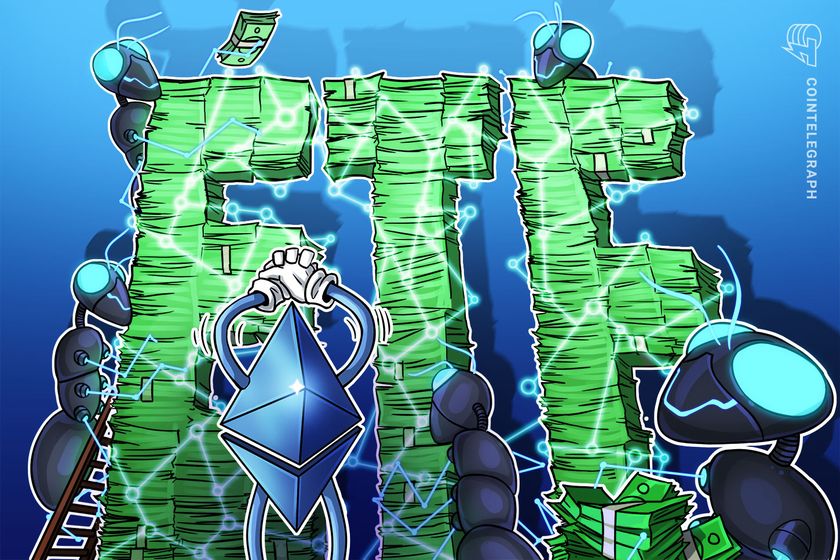Circle IPO further legitimizes crypto before regulators, outsiders

Circle’s share of the stablecoin market has grown to 23.5% in 2021, trailing only Tether. By going public, its “share will increase further?”
Circle’s merger with Concord Acquisition Corp, a special purpose acquisition company, or SPAC, values Circle at $4.5 billion, and the combined entity is expected to debut on the New York Stock Exchange under the ticker CRCL before the end of the year.
The merger/offering was generally applauded within the crypto industry. Vladimir Vishnevskiy, director and co-founder of Swiss wealth management firm St. Gotthard Fund Management AG, noted to Cointelegraph that Circle, the principal operator of USD Coin (USDC), the second-largest stablecoin by volume, “has been around since 2014, and this is another example of an established player being rewarded for their input into the ecosystem.”
Onward and upward
The overall crypto market may be moving sideways lately, but Circle has clearly been moving forward, closing the gap with stablecoin market leader Tether (USDT), which in February reached an $18.5-million settlement with New York State’s Attorney General for misrepresenting the degree to which USDT was backed by fiat collateral. Vishnevskiy noted, “USDC has gained market share from 14.3% to 23.5%, and now that it is going public it is highly likely that this market share will increase further, as Circle will have to disclose the assets that back this USDC stablecoin to the regulators.”
Circle is probably not harboring any surprises with regard to the assets backing its coins. As has been widely reported, USDC’s United States dollar reserves are attested to each month by top-five accounting services firm Grant Thornton LLP for the express purpose of ensuring that USDC is always redeemable for dollars.
Still, some were puzzled why Circle chose the SPAC route to access public equity markets. SPACs, sometimes called blank check companies because investors give sponsors a free hand, or “blank check” to make mergers, are a faster way to raise capital compared with traditional IPOs, but they sometimes favor insiders at the expense of public investors, according to critics.
Moreover, as John Griffin, who holds the James A. Elkins centennial chair in finance at the University of Texas, told Cointelegraph:
“Utilizing a SPAC is no longer the favored route to raising capital. SPACs peaked earlier in the year, and it is becoming recognized that firms often do SPACs because they can’t withstand the heavy scrutiny of an IPO.”
But Circle, unlike many crypto firms, has mostly welcomed regulation — as did the crypto public offering pioneer Coinbase. So, wouldn’t Circle, too, be able to survive the closer examination by regulators, analysts and institutional investors demanded in the traditional IPO roadshow process if it so chose? “Circle has historically been very compliant,” acknowledged Griffin, “and thus it makes it more puzzling that it is taking the SPAC route.”
Owen Lau, executive director at financial service firm Oppenheimer & Co. Inc., told Cointelegraph that SPACs are often favored by startups as a faster way to go public. Another attraction “is the ability for the SPAC to inject capital to the company,” said Lau, while David Trainer, CEO of investment research firm New Constructs, told Cointelegraph, “Perhaps, the Circle folks thought that not enough people would understand their business.”
SPACs, unlike traditional IPOs, also permit companies to make earnings and revenue projections. In its investor presentation that accompanied Circle’s IPO announcement, for instance, the firm said it expected to have had $190 billion of USDC in circulation by 2023 — up from $25 billion today — with a total transaction volume of $15 billion projected.
A poor time to tap public equity markets?
Some have criticized the timing of the IPO. When Coinbase was listed on Nasdaq in April, crypto prices were soaring and markets were awash with liquidity. Since mid-April, however, Bitcoin (BTC) has plunged by over 50%, and many other cryptocurrencies have followed.
“We are likely in the earlier stages of a so-called ‘crypto-winter,’ when interest in cryptocurrencies may wane over the next year-plus after the huge surge in late 2020 to early 2021. It strikes me as a bit early for Circle to [be] listing on the public markets,” Lisa Ellis, senior equity analyst at MoffettNathanson Research, told the Boston Globe.
Lau disagreed, explaining that timing an IPO is important for company insiders looking to sell their shares, but over the long term, “it really doesn’t matter that much.” The market is weighing a company over an extended period of time, and “the stock moves up and down based on the fundamentals and how well the management runs the company, not when the company goes public,” he added.
Related: China’s crypto industry is gone? Beijing’s crackdown keeps sending shockwaves
“Circle’s timing is definitely late to the party,” commented Griffin, adding, “but you can’t blame them for that, no one has perfect timing. But a listing today is going to receive a tepid reception compared to what it would have been in April.”
“The timing may seem a bit off, however, this is something I am sure that was looked at by the company and its advisors when making the decision,” said Vishnevskiy, who called the recent market weakness a short-term phenomenon. He added, “This is a segment of the digital asset market with little competition, and the fact that they have decided to go ahead must mean that they are confident of a successful result and achieving the valuation.”
Three revenue streams
Circle’s investor presentation identified three significant income streams. In addition to operating USDC’s core market infrastructure, where it earns interest income on reserves, Circle also has a Transaction & Treasury Services (TTS) segment, with clients, such as the FTX exchange, Compound Labs and Genesis, as well as a third business, SeedInvest, an equity crowdfunding platform.
TTS, which generates transaction and usage fees, as well as income via spread capture, is the largest segment by revenue — and also the fastest growing. While USDC revenues are projected to grow fivefold — from $40 million in 2021 to $196 million in 2023 — TTS revenues are expected to balloon almost tenfold — from $65 million to $622 million — according to the company, at which time TTS revenues will be three times USDC revenues.
Amid China’s cryptocurrency crackdown, souring investor sentiment and the United States Federal Reserve chairman blasting stablecoins, there hasn’t been much to cheer about on the crypto front lately, but Circle Internet Financial’s initial public offering announcement in mid-July showed that a crypto startup was still capable of attracting billions of dollars in fresh investments.

Circle arguably then offers more revenue diversification than crypto exchange Coinbase — whose earnings are still to a large degree dependent on the price of BTC and Ether (ETH). Moreover, the Circle business model “looks far more competitively advantaged than COIN,” according to Trainer, because it leverages blockchain technology to provide “a seamless transition from fiat to digital currency.”
In addition, Trainer believes that Circle “is not an existing technology/process with a blockchain veneer. It is using blockchain to improve the existing payment process and has real value to offer the world.” Lau, however, wasn’t ready to dismiss Coinbase. “The moat of Coinbase is quite strong due to its brand, on-ramp reputation, technological expertise, regulatory compliance and first-mover advantage,” he told Cointelegraph, adding:
“USDC is actually developed collaboratively between Coinbase and Circle. Partly because of Coinbase’s reputation and influence, USDC has gradually taken shares in the stablecoin space. Relatively speaking, there isn’t much differentiation you can do with a stablecoin, but you can really differentiate yourself as an exchange.”
Is the crypto sector consolidating?
How should this second major crypto IPO in 2021 be viewed in industry terms? If Coinbase’s direct listing was a milestone event for the crypto and blockchain sector, what can one say about Circle’s IPO?
“My first impression was that it was an ‘aha moment,’” Lau told Cointelegraph. “Circle didn’t come across as a company that would go public imminently. It makes me believe that there are many dark horses out there that couldn’t wait to go public soon.” It also suggests that you don’t need to be very large like Coinbase to go public, he added. Griffin took a less buoyant view:
“This could be a new milestone for the industry but not in a positive way. It signals the state of market decline relative to Coinbase’s direct and hot listing. If the best that Circle can do is a SPAC, then this is a negative signal to other players with shakier histories that the best they can hope for is a SPAC — though many are likely too late to the SPAC-time party as well.”
Still, few expected the IPO process to come undone. Imposition of new regulations on stablecoins — as per the STABLE Act — or the introduction of a major central bank digital currency could impact the future of stablecoins, suggested Lau, “but I wouldn’t say they would derail the public offering/merger. We will see how things go and keep our fingers crossed.”
Further validation for stablecoins?
All in all, “the [crypto] market may have cooled, but there is still a lot of hot money out there, and blockchain remains a hot topic,” Vishnevskiy said, while Stephen McKeon, a finance professor at the University of Oregon and a partner at Collab+Currency, told Cointelegraph, “the Circle transaction provides further validation of the market for stablecoins and, importantly, the market for services built on top of these assets.”
“Overall, I would regard this event as a further legitimization of the industry in the eyes of the regulators and outside observers,” summarized Vishnevskiy, adding that it is “significant considering the global regulatory crackdown and pressure we have witnessed over the last few months.”









